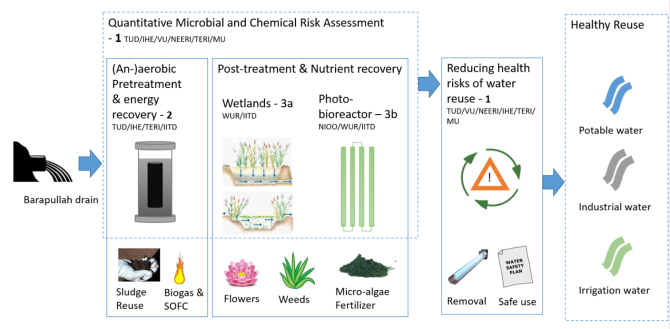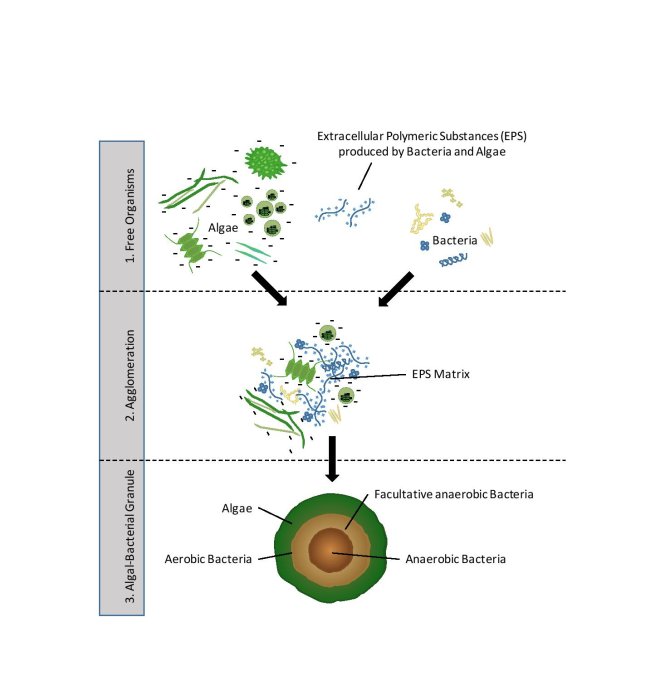
Project
Microalgal-bacteria communities for municipal wastewater treatment
The need for wastewater treatment systems to become more sustainable and recover nutrients rather than just removing them is becoming increasingly important. Microalgae is regarded as a potential candidate for biological nutrient recovery. This project will explore and investigate self-sedimenting algal-bacterial communities for municipal wastewater treatment in New Delhi, India.
Background
India’s rapid urbanization keeps on putting more stress on fresh water supply, while simultaneously water resources are polluted by untreated wastewater discharge. The project LotusHR will demonstrate a novel holistic (waste-)water management approach for the recovery of water, energy and nutrients from urban wastewater in the city of New Delhi (figure 1). One of the proposed technologies (project 3b) is using microalgae for biological nutrient recovery (BNR).

In recent years, the scientific and industrial interest in microalgae as an alternative BNR in wastewater treatment increased. The potential of microalgae to stir wastewater treatment towards energy efficiency and carbon neutrality stimulates the research in this field. Current state-of-the-art wastewater treatment technologies can recover phosphorus (Bio-P, struvite), but in most cases in an insufficient way. Moreover, other nutrients such as nitrogen and potassium are not recovered. Microalgae, on the other hand, can uptake not only phosphorus, but also nitrogen and other macro-/micro-elements, transforming them into valuable algae products (e.g. fertilizer, bioplastic, added value products).
One of the current bottlenecks in the application of microalgae technology in wastewater treatment is the energy-intensive separation step of biomass and treated liquid. Therefore, we suggest a photo-bioreactor (PBR) using a self-sedimenting microalgal-bacterial community, in the form of photo-granules for the treatment of municipal wastewater (figure 2). Using microalgal-bacterial aggregates might not only be beneficial for biomass separation but is expected to increase the overall nutrient recover efficiency. The proposed symbiosis of microalgae and bacteria might increase inorganic and organic pollutant removal and potentially reduces the need for aeration by internal CO2/O2 cycling (figure 3).

Aim
This project aims to develop a PBR using photo-granules, that can be operated in such a way to negate a further separation step for biomass. With this system macro-nutrients such as phosphorus, nitrogen and potassium, and microelements such as cobalt, magnesium, etc. are removed from wastewater and taken-up by the microalgal-bacterial community. The recovery of these nutrients will result in a biomass that can be used as a fertilizer and/or as a resource for added-value products for industry. Besides biomass generation, the removal efficiency of emerging pollutants (e.g. pharmaceuticals) in the PBR will be evaluated.
Approach
Screening experiments will be performed to obtain photo-granules with the desired sedimentation properties and nutrient removal capacities. The community assembly of the photo-granules will be performed in lab-scale sequencing batch reactors (SBR) where the influences of the operation strategy on the functions of the system will be investigated. To get a better insight into morphology of and interaction of microalgae and bacteria in the photo-granules, serval visualisation techniques (e.g. white light, fluorescent microscopy, CLSM, SEM) will be used. Further, methods will be developed to extract and characterize extracellular polymeric substances (EPS) - an important structural constituent of the photo-granules. Using molecular techniques such as 16S/18S sequencing, will provide valuable information about the microbial ecology of the proposed PBR system.

With the knowledge gained at lab-scale, PBR light models and kinetic microalgae growth models a pilot-scale PBR will be designed. Available space at the demonstration site, mode of operation, retention time, configuration, energy use and scaling-up potential will be considered for the pilot-scale design. The proposed PBR will subsequently be tested at two locations for performance: 1. NIOO-KNAW and 2. the project site at the Barapullah drain in New Delhi, India. The information collected from this will give valuable insight into the techno-economics of this wastewater treatment process.
The removal efficiency of emerging pollutants such as pharmaceuticals will be evaluated in the lab-scale and pilot-scale PBR systems. The mechanisms such as photolysis, sorption, biodegradation and oxidation responsible for the removal will be explored. Removal mechanisms that are related to the operating conditions of the PBR, such as high light and oxygen, might result in further removal of complex compounds.
Thesis project
There are different topics available for BSc or MSc thesis within the project at NIOO-KNAW but also at the project site in New Delhi, India (from 2019)! If you are interested, please feel free to contact me (via L.Trebuch@nioo.knaw.nl).